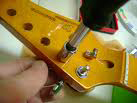In order to keep any musical instrument playing at its best, it needs to be properly maintained. The same applies for guitars as well. If a guitar is not well maintained, it will not perform like it is supposed to, no matter how good of a guitarist plays it. A nice guitar does not come cheap and buying even an average quality guitar can be a sizable investment for some folk. In such cases, proper guitar maintenance is crucial to ensure that the guitar functions properly for a very long time. Here are some essential guitar maintenance tips shared by some of the greatest guitarists in the business:
Clean after you play
Most guitarists make the mistake of not cleaning up their instrument after playing it. We would like to think that it is only amateurs who make this mistake, but the truth is that even some of the most experienced guitarists overlook this simple, yet crucial, step. All you have to do is use a soft dry cloth to wipe down the guitar right after playing. Pay special attention to wiping the strings since they are the most likely part of the guitar to pick up oil and dirt.
Polishing is good, but don’t overdo it
Too much of anything is harmful for you, no matter how good it is in small doses. The same relationship exists between guitar and polish. Many a fine guitar has been ruined thanks to owners who were over-zealous with their use of polish. Polishing is good; it gives the guitar a nice shine and provides a protective layer. However, polish too often and you will end up doing more harm than good to the instrument. You don’t go around polishing your wooden furniture once a week, so why do it to your guitar. Polish sparingly and remember to use sensible amounts of polish; you want to polish the guitar, not bathe it.
Keep an eye on the condition of the fingerboard & bridge
Most people simply wipe down the fingerboard and bridge and then forget about them. While it is good to clean them after every use, the wood will start drying out over time. It won’t weaken the guitar structurally, but it will definitely affect the quality of sound produced. A little lemon oil goes a long way to restore the fingerboard and bridge to a condition where they seem to be as good as new. It is possible to buy conditioners in stores specifically designed for this purpose, but none of them can match natural lemon oil. Conditioning the parts requires removal of the strings and is hence, best done only twice a year.
Buy a good case and a humidifier
Everyone probably understands why a good guitar case is an obvious recommendation, but will be stumped about the humidifier. How can a humidifier possibly help with guitar maintenance? Humidity levels are very important for properly maintaining wood and guitars do not get to be the exception to the rule. For naturally humid areas, a humidifier is not required. However, in dry places and air-conditioned studios, the low humidity levels will have a direct affect on the quality of music the guitar produces.
The 4 tips mentioned here may seem very simple, but are in fact essential for proper guitar maintenance.
This guest post is written by Jim Thomas. He helps provide guitar lessons online through his website which helps you choose between beginner, intermediate, advanced and master level programs.
